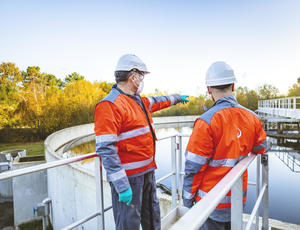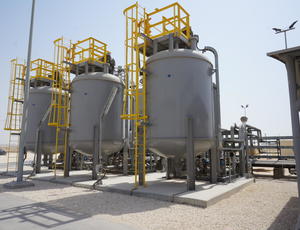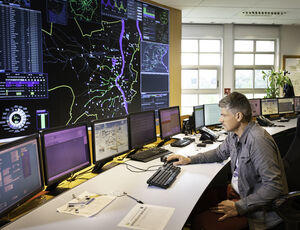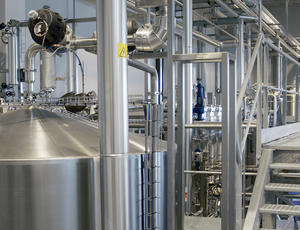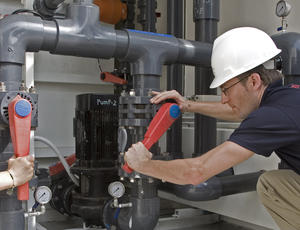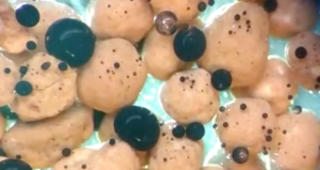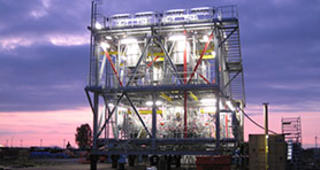Tilted Plate Separator Systems - oil water separation based on tilted plate packs to increase the separation surface.
Overview
Gravity separation is the most straightforward method of effluent treatment and is, therefore, utilized widely in industry for the separation of settling and/or floatable impurities from a carrier liquid.
MPP Systems, subsidiary of Veolia Water Technologies, offers a wide variety of services and solutions for gravity based separation. With extensive experience in designing, engineering, document control and fabrication according to the energy and CPI industry standards, we are able to customize each unit in order to meet your stringent specifications and requirements.
TiPSS™ stands for Tilted Plate Separator Systems, which means oil-water separation by gravity based on tilted lamellar plate packs. All TiPSS systems use lamellar plate sets in order to increase the separation surface. Corrugated plate interceptors (CPI) equipment is characterized by its reliability and simplicity along with flexibility in operation.
How do TiPSS™ technologies work?
Separation by gravity utilizes the density difference between two phases (liquid-liquid or liquid-solid). In the majority of the cases the separators are constructed in the form of a rectangular tank at atmospheric pressure. For pressurized applications a pressure vessel is used.
Plate packs are installed to improve separation efficiencies and/or to enlarge the separation capacities of existing separator vessels. Packs can be mounted without hot work in this existing vessel when necessary.
Removal efficiency is usually superior to gravity-based systems and often applied as a polishing step downstream of the CPI. The units can be supplied with a gas-tight cover, coagulation and flocculation dosing, and mixing equipment.
- Counter current flow CPI basins can be executed in steel or concrete. The concrete units are specifically suited to integrate with sewer systems below ground level so that a gravity flow can be used. The CPI with carbon steel coated tank can optionally be supplied with integrated oil sump, effluent sump and gas-tight cover, and is used above ground level.
- Cross flow CPI systems are used for streams containing high suspended solid (TSS) loads. The plate pack is customizable with regards to inclination, plate spacing and material.
- TiPSS™ DAF/DNF (dissolved air flotation / dissolved nitrogen flotation) technology uses extremely small air/nitrogen bubbles to lift suspended solids and oil to the top surface for separation. The formed sludge layer is scraped into a sludge holding tank by a moving skimmer. The addition of coagulation and flocculation chemicals may be required to enhance the performance.

Features and benefits

Separation by gravity, no moving parts

Minimal operator intervention while continuous operation

Low installation costs thanks to prefabricated modules

Reduce oil in water by 90%
Applications
Services
Resources and product range
CPI
1-PACK flow rate 30 m³/h till 10-PACK flow rate 300 m³/h
CF-CPI
2D1 flow rate 30 m³/h till 8D2 flow rate 250 m³/h
DAF / DGF
1-PACK 30 m³/h till 8-PACK 250 m³/h
Contact
Water is life. At Veolia we are passionate about the environment and about this precious resource and we want to share with you how to save water up to the last drop. Our treatment technologies contribute to this by the removal of hydrocarbons and solids prior to further treatment of the water and therefore protecting the environment. For us and the next generation!

Harm Uenk
Product Manager - TiPSS
Contact Harm through his LInkedIn account
FAQ about TiPSS™
Why is oil water separation a challenging treatment for oil and gas industries?
As a result of oil processing water is separated from the oil and treated as a separate stream. This water contains traces of oils that have to be removed before the water can be discharged. First to comply with the environmental regulations and to protect the environment.
What is gravity separation?
Gravity separation is the segregation of oil and solids from the water by the use of the difference in density between the water and the oil and solid particles. This method was developed by G.G. Stokes and is now known by the name of Stokes Law.
What are corrugated plate interceptors used for?
CPI’s are used to separate oil and solids from wastewater. Lamella plates placed under an angle of at least 45 degrees inside the separators are used to force the oil and solids to coalesce which results in faster and better separation.
Case Studies

Inaugurated in 2014, the Longford Gas Conditioning Plant treats water from the oil and gas operator ExxonMobil. To help our client meet the environmental regulations on oil in water discharge limits, we implemented a CPI, so that the contaminated water from all process catch basins is routed to the packaged unit. Cleaned water from the CPI is routed to the storm water pond and separated oily water is sent to the boot header. Treated water flows by gravity from CPI package to the storm water pond.
The CPI and storm water ponds are designed to be "dumb systems," in that they must be able to function in treating contaminated water and sending streams to their intended destinations without operator intervention, with the exception of routine system maintenance.



